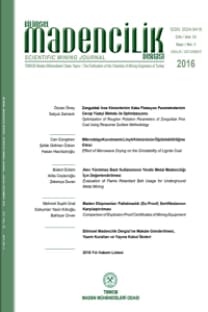KÜRE BAKIR CEVHERİNİN BAKTERİYEL LİÇİ
Bakterilerin günümüzde karıştırma ve yığın liçi proseslerinde kullanımı ile düşük tenörlü, kompleks cevherlerin ve madencilik artıklarının ekonomik olarak işlenmektedir. Küre Bakır işletmesi tesisine beslenen dissémine ve masif olarak adlandırılan iki farklı bakır cevherinin bir karışımı olan tüvenan cevher üzerinde bakteriyel liç deneyleri yapılmıştır. Bu liç işleminde, "Acidithiobacillus ferrooxidans" bakteri kültürü kullanılarak 576 saat boyunca; bakteri sayımı, pH, bakır ve demir kazanımları izlenmiştir. Katı oranının artmasıyla (%1- > %5) bakterinin oksidasyon yeteneği azalmakta ve bununla ilgili olarak liç hızı düşmektedir. Bu durumda bakır kazanımı % 68'den % 45' e, demir kazanımı ise % 35'den % 20'ye düşmektedir. Yapılan deneysel çalışmalar sonucunda, kullanılan bu bakteri türü için cevherin katı oranının artması ile bakır kazanım verimlerinin düştüğü gözlenmiştir
Anahtar Kelimeler:
Bakteriyel Liç, "Acidithiobacillus Ferrooxidans", Bakır Kazanımı, Sülfürlü Cevherler, Çevre, Biyoteknoloji
Bacterial Leaching of Kure Copper Ore
Currently, low-grade and complex ores and mining wastes can be processed economically by using bacteria in heap and agitation leaching processes. Bacterial leaching tests are performed on the runof-mine ore which is a mixture of two different massive and dissémine copper ores, fed to Küre Copper Plant. In this leaching process, using "Acidithiobacillus ferrooxidans" culture, bacteria count, pH, copper and iron recoveries are monitored during the 576 hours of test period. By increasing the solid ratio (1 %-»5 %) the oxidation ability of bacteria decreases, thus the leaching rate. Therefore copper and iron recoveries decreased from 68 %, 35 % and 45 %, 20 %, respectively. As a result of laboratory tests, it is found that as the pulp density increased, the efficiency of copper recovery decreased using this bacterial culture
Keywords:
Bacterial Leaching, "Acidithiobacillus Ferrooxidans", Copper Recovery, Sulphidic Ores, Environment, Biotechnology,
- ISSN: 2564-7024
- Yayın Aralığı: Yılda 4 Sayı
- Yayıncı: TMMOB Maden Mühendisleri Odası
